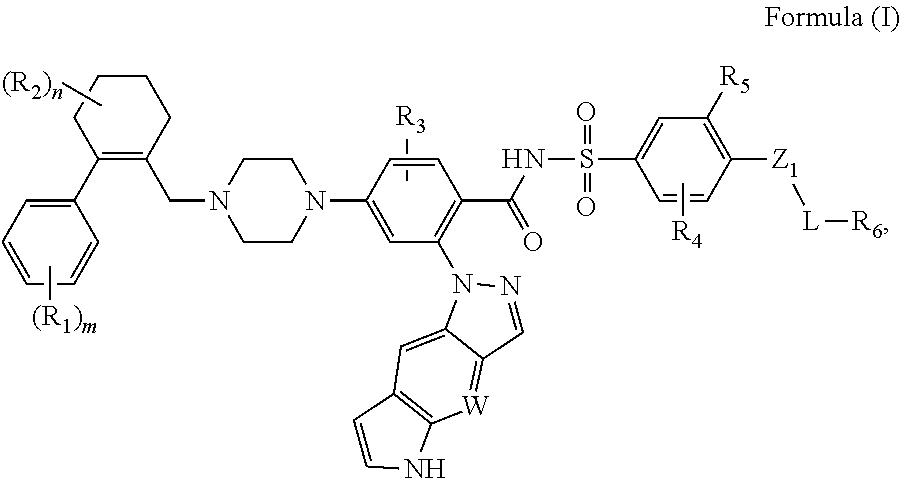Bcl-2 inhibitors
a technology of bcl-2 and inhibitors, which is applied in the field of bcl-2 inhibitors, can solve the problems of limiting the ability to drive drug concentrations into a highly efficacious range, rapid decrease of the number of circulating platelets, and difficult intravenous delivery formulation,
- Summary
- Abstract
- Description
- Claims
- Application Information
AI Technical Summary
Benefits of technology
Problems solved by technology
Method used
Image
Examples
example 1
on of Key Intermediate IM-14-1
[0134]
[0135]Synthesis of 2-bromo-4,4-dimethylcyclohex-1-enecarbaldehyde 2: A solution of anhydrous chloroform (57 ml) and anhydrous N,N-dimethylformamide (9 mL) was cooled to ˜3° C. (internal temperature) under nitrogen before phosphorus tribromide (10 mL, 0.1 mol) was introduced dropwise at a rate so that the reaction was maintained at ˜3° C. After the addition was complete the reaction was allowed to warm slowly to ˜10° C. and then the temperature was raised to 70° C. where it was maintained for 30 min. The reaction was cooled to rt and 3,3-dimethylcyclohexanone 1 (5 g, 0.04 mol) was added slowly over 20 min. After the addition was complete the reaction was warmed to 70° C. and it was stirred for 1.5 h. The mixture was then cooled to 0° C. and a solution of 4M sodium acetate (53 ml) was added slowly. The pH of the resulting solution was adjusted to ˜7 using a solution of 5M NaOH and the mixture was then extracted with heptanes (100 mL×3). The combined...
example 2
on of Key Intermediate IM-14-3
[0141]
[0142]Step 1: To a solution of compound 1 (200 g, 1.3 mol) in a solution of sulfuric acid (314 mL) and water (2.5 L) was added potassium iodide (217 g, 1.3 mol) and KIO3 (140 g, 655 mmol) at 20° C. The mixture was stirred at 80° C. for 4 h. TLC (petroleum ether:ethyl acetate=1:1, Rf=0.43) showed reactant was consumed completely, and one major new spot with larger polarity was detected. The five reactions were combined for workup. The mixture was cooled to RT and adjusted to pH 9 with the careful addition of NaOH (5N). Sodium sulfite saturated solution was added with vigorous stirring until the iodine color had been disappeared. A significant amount of brown solid remained out of solution, which was collected by filtration, washed with water (2000 mL) to give compound 2 (1.5 kg, 5.4 mol, 82.1% yield) as a brown solid. 1H NMR: (400 MHz, DMSO-d6) δ 8.50 (s, 1H), 2.58 (s, 3H).
[0143]Step 2: To a solution of compound 2 (387 g, 1.4 mol) in THF (2.4 L) wa...
example 3
ve Preparation of IM-14-3
[0149]
[0150]General procedure for preparation of compound 2: To a solution of 5-bromo-6-methyl-1H-pyrrolo[2,3-b]pyridine (10 g, 47.4 mmol, 1.00 eq) in DMF (150.00 mL), the mixture was cooled to 0° C. and NaH (2.84 g, 71 mmol, 60% purity, 1.50 eq) was added to the mixture. The reaction mixture was stirred at 0° C. for 1 hr, 2-(chloromethoxy)ethyl-trimethyl-silane (10.3 g, 61.6 mmol, 11 mL, 1.30 eq) was added dropwise to the mixture. The mixture was stirred at 25° C. for 3 hr. TLC indicated 0% of Reactant 1 was remained, and one major new spot with larger polarity (Petroleum ether:Ethyl acetate=5:1, Rf=0.51) was detected. The mixture was poured into NH4Cl solution (40 ml), concentrated, then extracted with EA (30 ml×3), combine the organic layers, washed with brine (20 ml), and concentrated to give crude product. The residue was purified by column chromatography (SiO2, Petroleum ether / Ethyl acetate=100 / 1 to 5:1). Compound 2 (10.00 g, 29.30 mmol, 61.84% yield) ...
PUM
| Property | Measurement | Unit |
|---|---|---|
| natural abundance | aaaaa | aaaaa |
| temperature | aaaaa | aaaaa |
| temperature | aaaaa | aaaaa |
Abstract
Description
Claims
Application Information
 Login to View More
Login to View More - R&D
- Intellectual Property
- Life Sciences
- Materials
- Tech Scout
- Unparalleled Data Quality
- Higher Quality Content
- 60% Fewer Hallucinations
Browse by: Latest US Patents, China's latest patents, Technical Efficacy Thesaurus, Application Domain, Technology Topic, Popular Technical Reports.
© 2025 PatSnap. All rights reserved.Legal|Privacy policy|Modern Slavery Act Transparency Statement|Sitemap|About US| Contact US: help@patsnap.com



